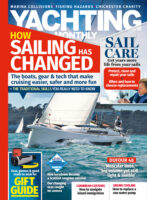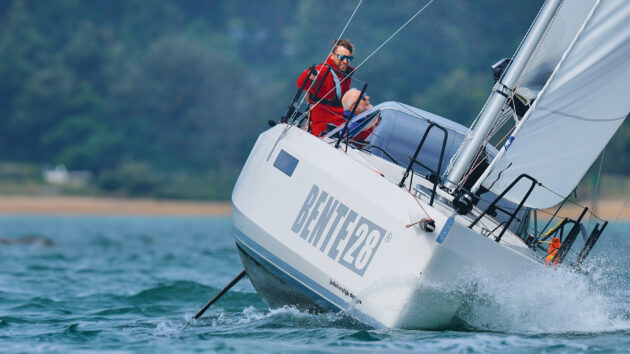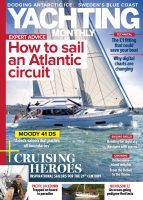The Bente 28 is a new 28-footer with a family-friendly layout that handles heavy weather like a much larger yacht. Theo Stocker takes it for a test
Bente 28 review: Can a 28ft cruising boat handle a family of five?
Having eaten dinner, I was down below washing up. Outside, wind was lashing rain across Yarmouth Harbour where we had taken shelter for the night, while our children entertained themselves with Lego and the baby slept. If a family of five on a 28-footer on a stormy weekend sounds like the recipe for disaster, you might be surprised.
We were on board the brand new Bente 28, which is unlike almost any other 28-footer I’ve sailed.
I wouldn’t normally test a boat with my whole family on board, but I’ve been looking forward to getting out on this cruising boat for almost a year and a half after I first saw her at the Düsseldorf boat show in 2024.
Taking a family of five cruising for a weekend of mixed British weather was, I reckoned, about as thorough a test of a coastal cruising boat as you could have. I did also take her out more recently for a ‘proper’ test and a photoshoot, where the wind was up into Force 6 where I’d normally be tucking in a second reef so we were on the overcanvassed side. The boat comes with a second single-line reefing line, and the sail has since had reefing added.
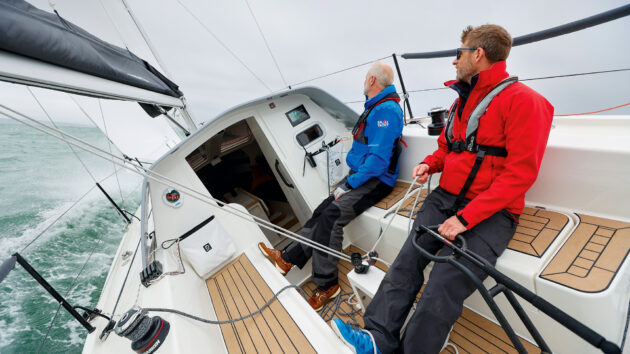
For a small boat the cockpit feels very secure. Photo: Paul Wyeth
Small boats evolution
So, why am I getting so excited about this boat in particular?
Well, for a number of years new boats have been getting bigger and bigger as yards have struggled to make money out of their smaller models before discontinuing them. It’s rare to find mainstream yards building almost anything under 34ft these days, notwithstanding small local yards, such as Swallow Yachts in Wales and Viko in Poland, and the anomaly of the Beneteau Oceanis 30.1, a veritable Tardis of a boat.
Article continues below…
But then the racing crowd realised that shorthanded offshore racing is fun (it is), and the discipline was mooted for the Olympic Sailing, leading to the arrival of high-performance 30-footers such as the offshore Dehler 30 One Design and the Jeanneau Sun Fast 30 One Design – both very cool little boats, but not really cruisers.
Then, like a phoenix emerging from insolvency after the development of its achingly cool but possibly too ‘out there’ 39-footer, Bente Yachts emerged under the stewardship of new owners Meichle and Mohr on the shores of Lake Constance.
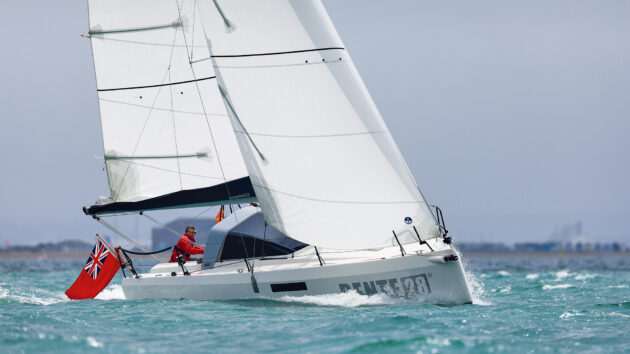
She is a powerful sailing boat and a genuinely capable sea boat with the potential for fast cruising speeds. Photo: Paul Wyeth
The diminutive Bente 24, which had launched the brand in 2014, still had a queue of customers, and the new owners were convinced there was a still a market for them, and for a scaled up version of the 24, albeit nothing as grand as the 39 (still available to order). They picked 28ft as the ideal size for a weekend (or longer) cruiser, and approached Judel/Vrolijk & Co to draw a boat hull that would follow in the footsteps of the other Bentes, as well as the trend for smaller, sporty boats, with modern lines and looks, coupled with their trademark ‘glass’ doghouse.
Introducing a new model is always risky for yacht builders, but if they wanted confirmation they were going in the right direction, Beneteau has followed suit with a new 30ft ‘planing cruiser’, the new First 30, for a similar price. This is probably the Bente 28’s closest competitor.
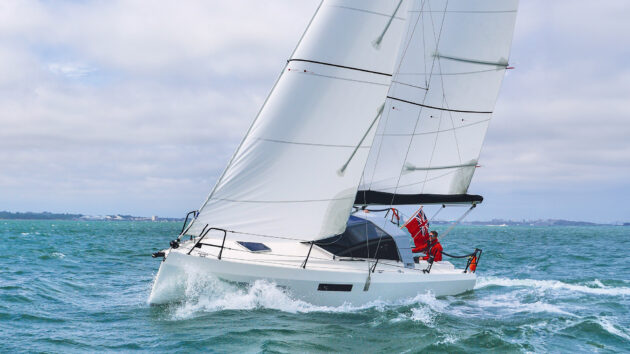
The sailplan is extremely generous for her size and displacement. Photo: Paul Wyeth
So it was that I found myself slipping the Bente 28 out of her berth on the Hamble river, wondering just how lumpy the Solent was going to be exactly, given the forecast of 20-25 knots, wind over tide. That would in theory give us apparent wind of over 30 knots close hauled. If ever you wanted to know how modern ultra-wide hull shapes handle waves, this was going to be it.
Bracing introduction
The shelter of Southampton Water let us get the sails up and tweaked accordingly. With a square-top main on a decent length mast, which is seated well aft, and a boom that extends all the way to the transom, this boat squeezes in a generous rig plan more akin to a Multihull or offshore race boat.
Consequently, she needs the sailplan to be right and initially overpowered as she was she tended to round up in the stronger gusts. Tuck a reef in the main, tension the halyards and add in some twist with the traveller, and she becomes much happier.
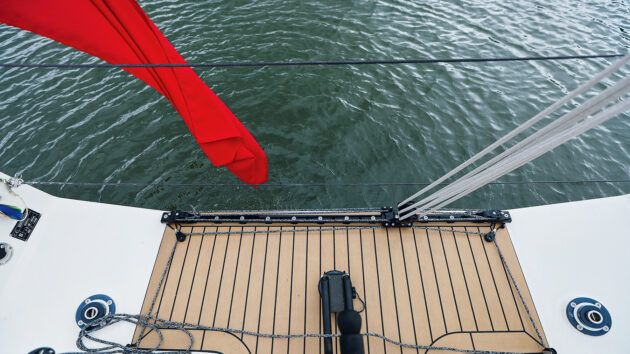
A traveller extends across the stern. Photo: Paul Wyeth
Clearing Calshot and emerging into Thorn Channel the full force of the wind facing up to the ebbing tides threw up a decent chop. This was where the boat was going to show what she’s made of.
It would have been nice to tuck in that second reef, now added by the sailmaker, and the new rig, still bedding in, could have done with some more tension. The result was that we were overcanvassed, and the forestay sagged to leeward in the gusts, which is harder to control on boats without a backstay (a cost of having that large square top).
As a result, we twisted out the top of the sails, which kept us driving powerfully, but probably pointing less than we might otherwise have done.
But what was impressive was that we were making good progress to windward, at over 6 knots, the beamy hull generating large amounts of power while the full, buoyant bow kept the head up and there was remarkably little water finding its way aft. Upwind, we feathered the main to keep us below 30
∘
of heel. Much more than that and the wide chines started to lift the keel, letting the boat develop leeway before coming more upright and jumping ahead again.
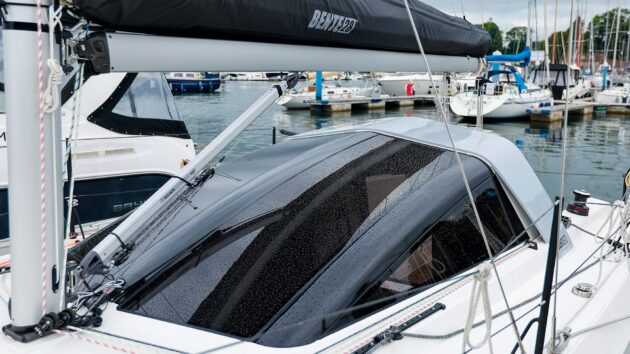
The Perspex coachroof looks cool and works well. Photo: Paul Wyeth
If I’m honest, I did miss having a backstay to crank on and flatten the main and tighten the forestay, but to do that on this boat you’d either have to sacrifice the square top main, or live with the additional complexity of running backstays, which doesn’t really sit with her ‘simple to sail’ vibes.
In terms of pointing, I was sailing pretty free – probably around 35º to the apparent to keep everything moving, with the speed frequently up over 6 knots. Had we had working wind instruments (some teething problems with the Windex were still being ironed out), I might have improved this, and when I sailed the boat on another occasion in light airs 32º∘was easily achievable.
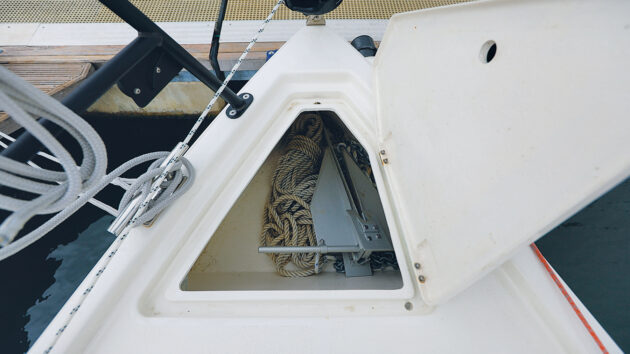
The anchor locker is deep enough for decent ground tackle but lacked a bow roller. Photo: Paul Wyeth
Sailplan options
Off the wind, we flew. On a beam reach under plain sail we were nudging over 9 knots – well over hull speed, and sitting consistently between 7.5 and 8.5 knots. The only gremlin here was again our ability to shorten sail. The long boom keeps power well aft in the boat and when there’s too much of it, the sailplan overpowered the rudders and started a gentle round up to windward. Had we had the courage to fly the asymmetric, set from a top-down furler on the end of the retractable carbon bowsprit, or alternatively had the option to reduce mainsail area, the boat would have been far better balanced.
On my other test sail in lighter airs, having set the kite before we set sail, everything could be controlled from the cockpit and we made excellent progress downwind with a well-balanced helm. As for speed, at 3.2 tonnes, this isn’t a heavy boat, but she is 160kg heavier than the 2ft longer First 30, which is just about as light as you can build a boat and still call it a cruiser. The Bente 28, with proper galley, heads, good quality fit-out and her glass bubble, is marginally less likely to plane, though would if you pushed her – she has the shape and sail area to do so.
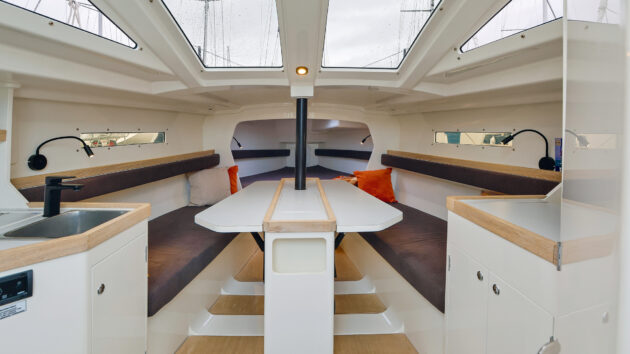
Headroom at the companionway is just massive at 2m. The views and light flooding in are amazing and the oak trim tastefully applied adds a touch of class down below. Photo: Paul Wyeth
If you need a test of handling a boat under engine, then go to Deacons Marina on the Hamble at peak flood tide, and you’ll soon find out what your boat can do. As with all twin rudder boats, speed is your friend.
As a small, light boat with plenty of power, this isn’t a problem. Just watch out in astern as twin rudders have plenty of force to snatch the tiller from your hands. Motoring back in at the end of our test, the 16hp Vetus motor with a folding two-bladed propeller pushed us along at 5 knots at 2,200rpm, and maxed out at 6 knots and 2,600rpm. These numbers are below those Bente has had on other boats, so possible causes are being looked into on our test boat.
On deck, the cockpit feels deep and secure with its high coamings and especially tucked behind the high coachroof and arch, though I would like to be able to plug the gap where the halyards come aft inside the arch, as wind and water can get through here. The open transom didn’t detract from the feeling of security, and no water came into the cockpit this way, despite the lively conditions (not children lost overboard).
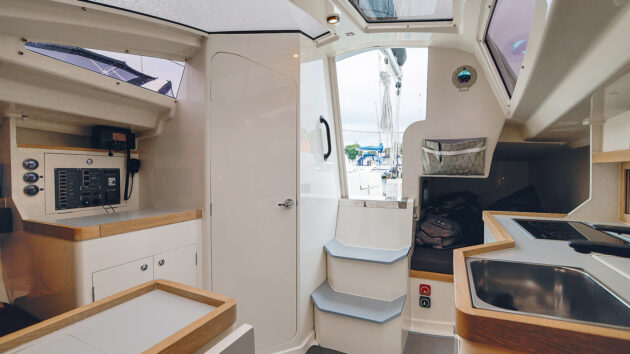
The companionway hatch widens at the top for better views and access. Photo: Paul Wyeth
A fold-up panel below the large, keyhole shaped companionway ensures a freeboard of 40cm above the cockpit sole to stop downflooding as specified by the RCD, while with this down, going below is a matter of three shallow steps. Cockpit stowage is excellent in the single large locker and soft rope bags, though an additional lazarette would be nice, and might aid access to the steering quadrants.
Plenty of space
Moving about on deck is easy thanks to wide sidedecks, clear other than for the lower shrouds and with decent moulded bulwarks. Occasionally you need to stand on top of the glass roof to zip up the sail bag, and some grip-tape on the black GRP supports would make this more secure. I’d also spec a grabrail somewhere on the coachroof to aid going forward under way.
With a flush deck, the foredeck has plenty of space to work. A small anchor locker was sufficient for the hand-launched Fortress anchor, 5m of chain, 10m of weighted line, and plain rope rode fitted to our test boat. For serious cruising, I’d be tempted by a heavier anchor, and a bow roller or a sprit-end snatch block to keep the anchor line away from the topsides when recovering the anchor.
At the stern, a telescopic bathing ladder pops out from the transom, with a deck shower for rinsing off; we got through water quite quickly on our weekend family cruise, and I would want to upgrade the 60-litre soft tank to a large, ideally rigid, moulded tank.
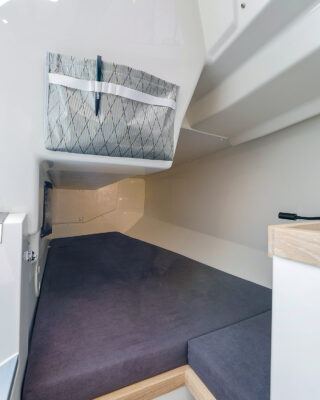
The quarter berth would fit two familiar adults but is perfect for children. Photo: Paul Wyeth
Where this boat stands head and shoulders above any possible competitors is that once down below, she is effectively a deck saloon, given the staggering 200cm of headroom in the galley and heads, with 185cm at the aft end of the saloon table, meaning there is no ducking and peering out of portholes even for tall crew.
This is thanks to the fact that abaft the keel frames, there is no cabin sole and you stand on the inside of the hull, which is covered in robust but soft foam decking. The low headroom around the saloon doesn’t matter as you’re sitting anyway, and there’s still 95cm of room above the forward berth, plenty for sitting up in bed, though the ring frame here did catch me out once or twice until I got used to it.
The moulded table itself is large, and has been well used to create large amounts of stowage with two small and one large bin locker, plus cubby holes at each end. The oak trim around most of the furniture was a lovely touch; I’d have like some around the edges of the folding leaves too.
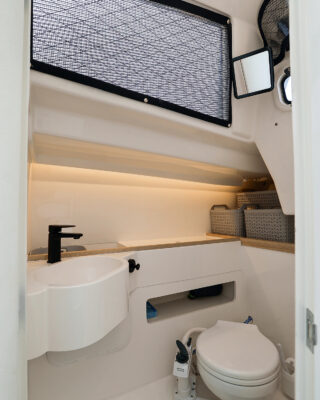
Acres of space in the heads compartment. Photo: Paul Wyeth
Aft of the saloon is a standing chart table to starboard (needs to be a tiny bit wider for leisure folio charts), with another big locker below and shallow storage under the lid, with a neatly arranged electrical locker outboard. Little touches like the long, deep shelves outboard of the seatbacks and the deep cubby outboard of the chart table meant there was plenty of space for the usual bits and bobs to go, not to mention the huge locker under the forward berth, and smaller ones under the saloon seats.
The galley is a decent size too with top opening fridge, single sink, and on this boat, a diesel Wallas cooking plate. The latter is great in that you don’t need gas on board and it takes almost no space, but it does take time to heat up and cool down (the blower lid kit would help make this safer).
For weekending and port-hopping, this was certainly sufficient. I’d be tempted to opt for induction if the power supply could be sufficient, or look into adapting the space for a gimballed oven, albeit at the cost of stowage.
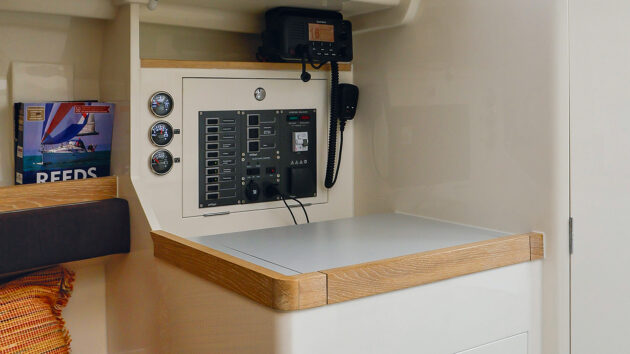
There is plenty of stowage and neat electrical installation above the compact chart table. Photo: Paul Wyeth
Ample accommodation
The heads too is huge, with lots of lockers and cubby holes, and space aft for a hanging rail for wet gear and lifejackets, and the calorifier in the locker abaft the toilet. A shower and floor grating is an option in here, but not fitted to the test boat. Finally, tucked into the port quarter is a long double berth that was fine for two children, but would be cosy for two adults. The forward vee-berth is a massive 200cm wide and 197cm long.
The only thing I’d add here if this was my own boat would be a couple of grab holds for moving around, in addition to the one by the companionway.
Engine access, once the steps are lifted away is good for the alternator (marine/engine), but the boat fell down on access to the water strainer, primary fuel filter and saildrive.
With the water strainer aft of the engine, it could only be inspected by feel, and the fuel tank and primary filter are in a separate compartment under the cockpit sole, accessed by emptying and climbing into the cockpit locker – not a realistic proposition at sea. Additional hatches from the quarterberth can be specified to make accessing these systems easier.
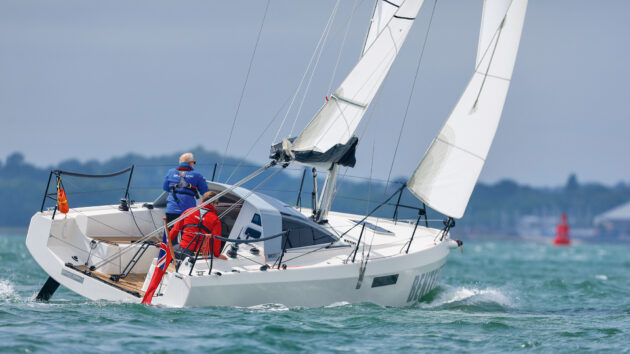
Lively conditions were a good test of her performance. Photo: Paul Wyeth
Bente 28 specifications
Price as tested: £157,000 inc VAT
LOA: 8.65m / 28ft 5in
LWL: 7.83m / 25ft 8in
Beam: 2.99m / 9ft 10in
Draught: 1.6m/5ft 3in
Optional T-keel draught: 1.95m / 6ft 5in
Displacement: 3,200kg / 7,055 lb
Ballast: 995kg / 2,193 lb
Sail area: 55.2m2 / 594 sq ft
Bal/disp ratio: 31%
Disp/length: 183
SA/D Ratio: 25.9
Engine Vetus: 16hp Transmission Saildrive
Water: 60L
Fuel: 60L
RCD: Category B
Designer: Judel/Vrolijk & Co
Builder: Yacht Service Poland
Enjoyed reading this?
A subscription to Yachting Monthly magazine costs around 40% less than the cover price, so you can save money compared to buying single issues.
Print and digital editions are available through Magazines Direct – where you can also find the latest deals.
YM is packed with information to help you get the most from your time on the water.
-
-
- Take your seamanship to the next level with tips, advice and skills from our experts
- Impartial in-depth reviews of the latest yachts and equipment
- Cruising guides to help you reach those dream destinations
-
Follow us on Facebook, Twitter and Instagram.
Note: We may earn a commission when you buy through links on our site, at no extra cost to you. This doesn’t affect our editorial independence.
Verdict
What this boat has achieved is quite remarkable. For a genuinely sensible price tag, Bente has created a sensibly-sized cruising boat that is ideally suited to coastal cruising in the UK whatever the weather – something that very few yards seem able to do these days. She has acres more space than most other 28-footers and she’ll sail a good deal faster too. Her accommodation really works, and she is a pleasure to be aboard, even for longer periods, as long as you don’t mind the lack of separate cabins. Everything is finished to a high standard for the price, and with very few rough edges. The final fit out and finish can be specced by an owner, and you’ll want either the insulating blinds or the blackout cover for the coachroof windows and maybe a couple of opening hatches or vents. Engine access isn’t ideal, but more inspection hatches can be specced. I’d also spec more grab handles, and something to stop water coming under the cockpit arch when it's rough. Sail controls are well laid out and she’s easily handled. Tensioning the rig and adding a reef or two more should keep things calm in stronger winds.

